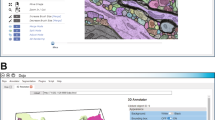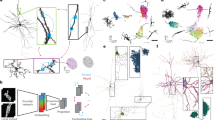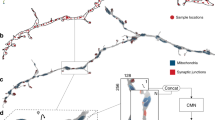Abstract
Understanding of neuronal circuitry at cellular resolution within the brain has relied on neuron tracing methods that involve careful observation and interpretation by experienced neuroscientists. With recent developments in imaging and digitization, this approach is no longer feasible with the large-scale (terabyte to petabyte range) images. Machine-learning-based techniques, using deep networks, provide an efficient alternative to the problem. However, these methods rely on very large volumes of annotated images for training and have error rates that are too high for scientific data analysis, and thus requires a substantial volume of human-in-the-loop proofreading. Here we introduce a hybrid architecture combining prior structure in the form of topological data analysis methods, based on discrete Morse theory, with the best-in-class deep-net architectures for the neuronal connectivity analysis. We show significant performance gains using our hybrid architecture on detection of topological structure (for example, connectivity of neuronal processes and local intensity maxima on axons corresponding to synaptic swellings) with precision and recall close to 90% compared with human observers. We have adapted our architecture to a high-performance pipeline capable of semantic segmentation of light-microscopic whole-brain image data into a hierarchy of neuronal compartments. We expect that the hybrid architecture incorporating discrete Morse techniques into deep nets will generalize to other data domains.
This is a preview of subscription content, access via your institution
Access options
Access Nature and 54 other Nature Portfolio journals
Get Nature+, our best-value online-access subscription
$29.99 / 30 days
cancel any time
Subscribe to this journal
Receive 12 digital issues and online access to articles
$119.00 per year
only $9.92 per issue
Buy this article
- Purchase on Springer Link
- Instant access to full article PDF
Prices may be subject to local taxes which are calculated during checkout





Similar content being viewed by others
Data availability
The STPT data were collected as a part of the Brain Initiative Cell Census Network and shared online. The raw images of the STPT dataset are available from ftp://download.brainimagelibrary.org:8811/biccn/huang/connectivity/anterograde/180830_JH_WG_Fezf2LSLflp_CFA_female_processed/. The sample MBA data can be viewed at http://brainarchitecture.org/viewer4/mouse/map/3611. The trained models and the annotated data are available at http://brainarchitecture.org/semantic-segmentation-in-brain-images.
Code availability
The process detection and semantic segmentation code for reproduction of the results in this paper and limited data with their links and documentation are available on Github at https://github.com/samik1986/ML_Semantic_Segmenation_NMI.
References
Bohland, J. W. et al. A proposal for a coordinated effort for the determination of brainwide neuroanatomical connectivity in model organisms at a mesoscopic scale. PLoS Comput. Biol. 5, e1000334 (2009).
Dodt, H.-U. et al. Ultramicroscopy: three-dimensional visualization of neuronal networks in the whole mouse brain. Nat. Methods 4, 331–336 (2007).
Ragan, T. et al. Serial two-photon tomography for automated ex vivo mouse brain imaging. Nat. Methods 9, 255 (2012).
Oh, S. W. et al. A mesoscale connectome of the mouse brain. Nature 508, 207–214 (2014).
Pinskiy, V. et al. High-throughput method of whole-brain sectioning, using the tape-transfer technique. PLoS ONE 10, e0102363 (2015).
Lin, M. K. et al. A high-throughput neurohistological pipeline for brain-wide mesoscale connectivity mapping of the common marmoset. eLife 8, e40042 (2019).
Halavi, M., Hamilton, K. A., Parekh, R. & Ascoli, G. Digital reconstructions of neuronal morphology: three decades of research trends. Front. Neurosci. 6, 49 (2012).
Helmstaedter, M. & Mitra, P. P. Computational methods and challenges for large-scale circuit mapping. Curr. Opin. Neurobiol. 22, 162–169 (2012).
Peng, H., Meijering, E. & Ascoli, G. A. From DIADEM to BigNeuron. Neuroinform. 13, 259–260 (2015).
Rey-Villamizar, N. et al. Large-scale automated image analysis for computational profiling of brain tissue surrounding implanted neuroprosthetic devices using Python. Front. Neuroinform. 8, 39 (2014).
Peng, H. et al. BigNeuron: large-scale 3D neuron reconstruction from optical microscopy images. Neuron 87, 252–256 (2015).
Lawrie, S. M. & Abukmeil, S. S. Brain abnormality in schizophrenia: a systematic and quantitative review of volumetric magnetic resonance imaging studies. Br. J. Psychiatry 172, 110–120 (1998).
Taylor, R. H., Lavealle, S., Burdea, G. C. & Mosges, R. Computer-integrated Surgery: Technology and Clinical Applications (MIT Press, 1995).
Zijdenbos, A. P. & Dawant, B. M. Brain segmentation and white matter lesion detection in MR images. Crit. Rev. Biomed. Eng. 22, 401–465 (1994).
Worth, A. J., Makris, N., Caviness, V. S.Jr & Kennedy, D. N. Neuroanatomical segmentation in MRI: technological objectives. Int. J. Pattern Recognit. Artif. Intell. 11, 1161–1187 (1997).
Khoo, V. S. et al. Magnetic resonance imaging (MRI): considerations and applications in radiotherapy treatment planning. Radiother. Oncol. 42, 1–15 (1997).
Grimson, W. E. L. et al. Utilizing segmented mri data in image-guided surgery. Int. J. Pattern Recognit. Artif. Intell. 11, 1367–1397 (1997).
LeCun, Y., Bengio, Y. & Hinton, G. Deep learning. Nature 521, 436–444 (2015).
LeCun, Y., Bottou, L., Bengio, Y. & Haffner, P. Gradient-based learning applied to document recognition. Proc. IEEE 86, 2278–2324 (1998).
Fukushima, K. Neocognitron: a self-organizing neural network model for a mechanism of pattern recognition unaffected by shift in position. Biol. Cybern. 36, 193–202 (1980).
Pahariya, G. et al. High precision automated detection of labeled nuclei in gigapixel resolution image data of mouse brain. Preprint at BioRxiv https://doi.org/10.1101/252247 (2019).
Ramesh, N., Yoo, J.-H. & Sethi, I. Thresholding based on histogram approximation. In IEEE Proc.—Vision, Image and Signal Processing Vol. 142, 271–279 (IEEE, 1995).
Sharma, N. et al. Segmentation and classification of medical images using texture-primitive features: application of BAM-type artificial neural network. J. Med. Phys. 33, 119–126 (2008).
Boykov, Y. Y. & Jolly, M.-P. Interactive graph cuts for optimal boundary and region segmentation of objects in nd images. In Proc. Eighth IEEE International Conference on Computer Vision, ICCV 2001 Vol. 1, 105–112 (IEEE, 2001).
Litjens, G. et al. A survey on deep learning in medical image analysis. Med. Image Anal. 42, 60–88 (2017).
Krizhevsky, A., Sutskever, I. & Hinton, G. E. ImageNet classification with deep convolutional neural networks. In Advances in Neural Information Processing Systems 25 (NIPS 2012) 1097–1105 (NIPS, 2012).
He, K., Gkioxari, G., Dollár, P. & Girshick, R. Mask R-CNN. In Proc. IEEE International Conference on Computer Vision 2961–2969 (IEEE, 2017).
Redmon, J., Divvala, S., Girshick, R. & Farhadi, A. You only look once: unified, real-time object detection. In Proc. IEEE Conference on Computer Vision and Pattern Recognition 779–788 (IEEE, 2016).
Vinyals, O., Toshev, A., Bengio, S. & Erhan, D. Show and tell: lessons learned from the 2015 MSCOCO image captioning challenge. IEEE Trans. Pattern Anal. Mach. Intell. 39, 652–663 (2016).
Sabour, S., Frosst, N. & Hinton, G. E. Dynamic routing between capsules. In Advances in Neural Information Processing Systems 30 (NIPS 2017) 3856–3866 (NIPS, 2017).
Badrinarayanan, V., Kendall, A. & Cipolla, R. Segnet: a deep convolutional encoder–decoder architecture for image segmentation. IEEE Trans. Pattern Anal. Mach. Intell. 39, 2481–2495 (2017).
Ronneberger, O., Fischer, P. & Brox, T. U-net: convolutional networks for biomedical image segmentation. In Int. Conference on Medical Image Computing and Computer-assisted Intervention 234–241 (Springer, 2015).
Buslaev, A., Seferbekov, S. S., Iglovikov, V. & Shvets, A. Fully convolutional network for automatic road extraction from satellite imagery. In 2018 IEEE/CVF Conference on Computer Vision and Pattern Recognition Workshops (CVPRW) 197–1973 (IEEE, 2018).
Belkin, M., Hsu, D. J. & Mitra, P. Overfitting or perfect fitting? Risk bounds for classification and regression rules that interpolate. Advances in Neural Information Processing Systems 31 (NIPS 2018) 2300–2311 (NIPS, 2018).
Ciçek, Ö., Abdulkadir, A., Lienkamp, S. S., Brox, T. & Ronneberger, O. 3D U-Net: learning dense volumetric segmentation from sparse annotation. In International Conference on Medical Image Computing and Computer-assisted Intervention 424–432 (Springer, 2016).
Milletari, F., Navab, N. & Ahmadi, S.-A. V-Net: fully convolutional neural networks for volumetric medical image segmentation. In 2016 Fourth International Conference on 3D Vision (3DV) 565–571 (IEEE, 2016).
Johnson, J. M. & Khoshgoftaar, T. M. Survey on deep learning with class imbalance. J. Big Data 6, 27 (2019).
Delgado-Friedrichs, O., Robins, V. & Sheppard, A. Skeletonization and partitioning of digital images using discrete Morse theory. IEEE Trans. Pattern Anal. Mach. Intell. 37, 654–666 (2014).
Gyulassy, A., Bremer, P.-T., Hamann, B. & Pascucci, V. A practical approach to Morse–Smale complex computation: scalability and generality. IEEE Trans. Vis. Comput. Graph. 14, 1619–1626 (2008).
Robins, V., Wood, P. J. & Sheppard, A. P. Theory and algorithms for constructing discrete Morse complexes from grayscale digital images. IEEE Trans. Pattern Anal. Mach. Intell. 33, 1646–1658 (2011).
Dey, T. K., Wang, J. & Wang, Y. Road network reconstruction from satellite images with machine learning supported by topological methods. In Proc. 27th ACM SIGSPATIAL International Conference on Advances in Geographic Information Systems 520–523 (ACM, 2019).
Edelsbrunner, H. & Harer, J. Persistent homology—a survey. Contemp. Math. 453, 257–282 (2008).
Forman, R. A user’s guide to discrete Morse theory. Sém. Lothar. Combin. 48, B48c (2002).
Sousbie, T., Pichon, C., Colombi, S., Novikov, D. & Pogosyan, D. The 3D skeleton: tracing the filamentary structure of the Universe. Mon. Not. R. Astron. Soc. 383, 1655–1670 (2008).
Acknowledgements
We gratefully acknowledge IHC Brightfield Imaged data from P. Strick at U Pitt, and thank J. Nagashima and M. Hanada also at U Pitt for annotating these images. We acknowledge the effort from annotators at the Center for Computational Brain Research at IIT Madras for the bulk of the data annotation and proofreading for this project. This work was supported by the NIH (EB022899, MH114824, MH114821, NS107466, AT010414), the Crick-Clay Professorship (Cold Spring Harbor Laboratory), the Mathers Charitable Foundation, and H. N. Mahabala Chair (IIT Madras). Work at Ohio State University was in addition partly supported by the NSF under grants CCF-1740761, RI-1815697 and DMS-1547357.
Author information
Authors and Affiliations
Contributions
The idea of using topological priors in the pipeline was conceptualized by Y.W. and P.P.M. Algorithmic design and development was performed by S.B. and L.M. Proofreading assistance and neuroanatomical expertise for neuroanatomical ground truth data was provided by J.J. and K.M. Data preparation, including quality control and acquisition, was performed by B.-X.H., J.J. and K.M. under the supervision of J.H. and P.P.M. The ALBU baseline was tested by D.W. Evaluation of the algorithm was conducted by S.B., D.W., L.M. and X.L. Data preparation, including design of an online proofreading interface and hosting, was done by M.-K.L., M.S. and K.R. S.B., L.M., J.J. and P.P.M. prepared and edited the paper.
Corresponding author
Ethics declarations
Competing interests
The authors declare no competing interests.
Additional information
Publisher’s note Springer Nature remains neutral with regard to jurisdictional claims in published maps and institutional affiliations.
Extended data
Extended Data Fig. 1 Working of Discrete Morse Algorithm.
The Discrete Morse algorithm is given an input image (a). A Gaussian filter is applied to the image (b) - a density function is defined at the pixels. Then the algorithm extracts the ridges of the function across the domain (c) - these ridges form the 1-stable manifold. Finally, each path in the 1-stable manifold is assigned an grayscale value based on intensity along the path, and a grayscale mask is outputted in (d).
Supplementary information
Supplementary Information
Supplementary Figs. 1–5, evaluations, discussion and Tables 1–7.
Rights and permissions
About this article
Cite this article
Banerjee, S., Magee, L., Wang, D. et al. Semantic segmentation of microscopic neuroanatomical data by combining topological priors with encoder–decoder deep networks. Nat Mach Intell 2, 585–594 (2020). https://doi.org/10.1038/s42256-020-0227-9
Received:
Accepted:
Published:
Issue Date:
DOI: https://doi.org/10.1038/s42256-020-0227-9
This article is cited by
-
Convolutional neural network based tea leaf disease prediction system on smart phone using paas cloud
Neural Computing and Applications (2023)
-
A reusable neural network pipeline for unidirectional fiber segmentation
Scientific Data (2022)



